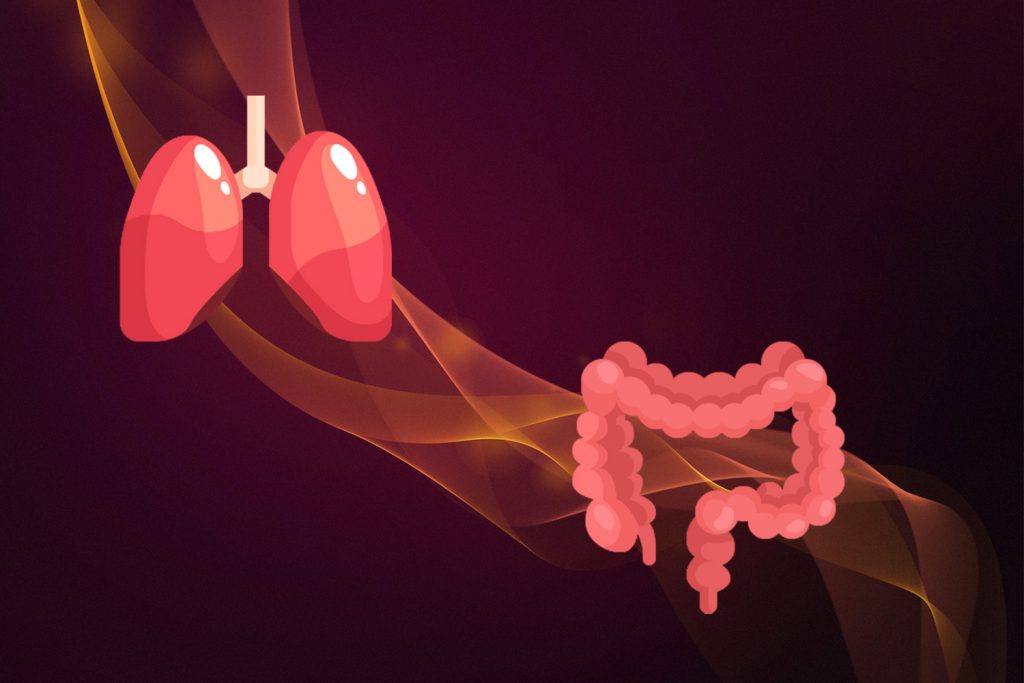The term “Gut-Lung Axis” refers to the intricate relationship between our digestive system and respiratory health. This connection is not just a modern scientific discovery but an evolving field of study that emphasizes the importance of holistic health. As we delve into the complexities of this axis, we realize that it is much more than a simple interaction between two bodily systems; it is a dynamic interplay that affects our overall well-being.
Understanding the gut-lung axis starts with recognizing the systemic nature of our bodies. The gastrointestinal tract and the respiratory system are both lined with mucosal surfaces, which play a crucial role in immune function. These surfaces act as barriers and communication hubs, transferring signals and responses that influence inflammation and immunity. This means that disturbances in one system can significantly impact the other. This axis is a bi-directional pathway, meaning that respiratory infections can influence gut health and vice versa, further emphasizing the need for comprehensive health approaches.
Functions of the Gut-Lung Axis
The functions of the gut-lung axis are multifaceted and crucial for maintaining overall health. One of the primary roles is to regulate immune responses. The gut-associated lymphoid tissue (GALT) and the bronchus-associated lymphoid tissue (BALT) work collaboratively to ensure a balanced immune response. This synergy helps in protecting against pathogens and maintaining homeostasis [1-4].
Another critical function is the modulation of inflammation. Chronic inflammation in the gut can lead to systemic effects, including respiratory disorders. The gut-lung axis plays a vital role in managing inflammatory signals through the production of cytokines and other immune modulators [1]. This regulation is essential for preventing chronic respiratory conditions such as asthma and chronic obstructive pulmonary disease (COPD) [3].
Additionally, the gut-lung axis is involved in the maintenance of the epithelial barrier integrity in both systems. A healthy gut lining prevents the migration of harmful bacteria and toxins into our blood, which can otherwise lead to systemic inflammation and respiratory issues. Similarly, a robust epithelial barrier in the lungs ensures protection against environmental pollutants and allergens, further highlighting the interconnectedness of these systems.
The Role of the Microbiome in the Gut-Lung Axis
The microbiome plays a pivotal role in the gut-lung axis. These microbes are not just passive inhabitants; they actively contribute to the regulation of immune responses and inflammation. The gut microbiome, in particular, produces short-chain fatty acids (SCFAs) that have systemic anti-inflammatory effects, benefiting lung health as well [1,2].
Studies have shown that a diverse and balanced microbiome is essential for a well-functioning gut-lung axis. Dysbiosis, or microbial imbalance, can lead to increased susceptibility to infections and inflammatory diseases in both the gut and lungs [1-3]. For example, certain microbial compositions are associated with a higher risk of asthma and other allergic conditions, demonstrating the need for microbiome diversity.
Furthermore, the gut microbiome influences the maturation and function of immune cells that are crucial for lung health. These immune cells, once educated in the gut, travel to the lungs and other parts of the body, providing a line of defense against pathogens. Thus, maintaining a healthy microbiome is integral to supporting both digestive and respiratory functions.
Probiotics and the Gut-Lung Axis: How They Interact
Probiotics have gained attention for their potential to modulate the gut-lung axis positively. These microorganisms can restore and maintain a healthy gut microbiome, thereby indirectly supporting lung health. By enhancing the gut’s microbial balance, probiotics help in reducing systemic inflammation, which is a common pathway for many respiratory ailments.
The interaction between probiotics and the gut-lung axis is complex and involves multiple mechanisms. Probiotics can enhance the production of SCFAs, which have been shown to exert protective effects on lung tissues. Additionally, they help in strengthening the gut barrier, preventing the movement of harmful pathogens out of the gut that could trigger inflammatory responses in the lungs [2].
Clinical trials have demonstrated that certain probiotic strains can reduce the incidence and severity of respiratory infections, particularly in vulnerable populations such as children and the elderly [5]. This evidence points to the potential of probiotics as a supportive therapy for maintaining a healthy gut-lung connection, making them an attractive option for those seeking natural ways to boost their respiratory health.
Signs of Imbalance in the Gut-Lung Axis
Recognizing the signs of imbalance in the gut-lung axis is crucial for early intervention and maintaining overall health. Common indicators include frequent respiratory infections, chronic cough, and unexplained wheezing, which may suggest a disrupted gut-lung connection. These symptoms often occur alongside digestive issues such as bloating, irregular bowel movements, and abdominal discomfort [3,4].
Another sign of imbalance is the presence of skin conditions like eczema or psoriasis, which can be linked to systemic inflammation originating from the gut. These skin manifestations often accompany respiratory symptoms, highlighting the interconnected nature of our body’s systems. Identifying these signs early can lead to more effective management and prevention strategies.
Furthermore, fatigue and reduced exercise tolerance can also be indicative of a gut-lung axis imbalance. These symptoms may result from chronic inflammation and impaired nutrient absorption due to poor gut health.
Practical Tips for Maintaining a Healthy Gut-Lung Connection
Maintaining a healthy gut-lung connection involves a combination of lifestyle choices and proactive health measures. Here are some practical tips to support this vital axis:
- Balanced Diet: Prioritize whole foods, rich in fiber, probiotics, and omega-3 fatty acids to support gut and lung health. Incorporating probiotic-rich foods such as yogurt, kefir, and fermented vegetables can also help maintain a balanced gut microbiome. These foods introduce live beneficial bacteria that support gut health and, by extension, respiratory function. Additionally, omega-3 fatty acids found in fish, flaxseeds, and walnuts have anti-inflammatory properties that benefit both the gut and lungs.
- Regular Exercise: Engage in physical activities that promote circulation and respiratory efficiency.
- Stress Management: Incorporate stress-reducing practices such as meditation, yoga, or deep-breathing exercises to support immune function.
- Adequate Sleep: Ensure restful sleep to allow the body to repair and rejuvenate, benefiting both digestive and respiratory systems.
- Avoid Smoking: Smoking directly harms lung health and disrupts the gut microbiome, so cessation is crucial.
- Limit Processed Foods: It’s also important to limit the intake of processed foods, refined sugars, and trans fats, which can disrupt the microbiome and promote inflammation.
By adopting these strategies, we can actively contribute to a robust gut-lung axis, enhancing both our digestive and respiratory well-being.
The Future of Gut-Lung Axis Research
The future of gut-lung axis research holds exciting potential for advancing our understanding of this intricate connection. Emerging studies are exploring the genetic and epigenetic factors that influence the gut-lung relationship, offering insights into personalized approaches for managing respiratory and digestive health. As our knowledge grows, we can expect more targeted therapies and interventions.
One promising area of research is the development of microbiome-based therapies, including precision probiotics tailored to individual needs [6]. These therapies aim to modulate the microbiome in ways that specifically benefit both gut and lung health. Advances in technology, such as metagenomic sequencing, are enabling researchers to identify specific microbial strains that play pivotal roles in the gut-lung axis.
Moreover, researchers are investigating the role of environmental factors, such as pollution and lifestyle, influencing the gut-lung connection. Understanding these influences can lead to public health strategies that mitigate risks and promote community well-being. The future of gut-lung axis research is bright, with the potential to revolutionize how we approach health and disease prevention.
Final Thoughts
In conclusion, the gut-lung axis represents a vital area of health that underscores the interconnectedness of our body’s systems. Understanding and supporting this axis is crucial for maintaining optimal digestive and respiratory health. By focusing on diet, lifestyle, and emerging research, we can nurture a balanced gut-lung connection, enhancing our overall wellness.
As we continue to explore this fascinating field, it’s important to stay informed and proactive about our health. Embracing a holistic approach that includes attention to the gut-lung axis can lead to significant improvements in quality of life. Let’s prioritize our health by recognizing the power of the gut-lung connection and taking steps to support it.
Sources
[1] Dang, Anh Thu et al. (2019). Microbes, metabolites, and the gut–lung axis. Mucosal Immunology, 12 (4), 843 – 850. https://doi.org/10.1038/s41385-019-0160-6
[2] Indari, A., Rasmin, M., & Fahrial Syam, A. (2023). Gut-Lung Axis. Respiratory Science, 3(2), 132-143. https://doi.org/10.36497/respirsci.v3i2.68
[3] Enaud, R., Prevel, R., Ciarlo, E., Beaufils, F., Wieërs, G., Guery, B., & Delhaes, L. (2020). The Gut-Lung Axis in Health and Respiratory Diseases: A Place for Inter-Organ and Inter-Kingdom Crosstalks. Frontiers in cellular and infection microbiology, 10, 9. https://doi.org/10.3389/fcimb.2020.00009
[4] Budden, K., Gellatly, S., Wood, D. et al. (2017). Emerging pathogenic links between microbiota and the gut–lung axis. Nat Rev Microbiol 15, 55–63. https://doi.org/10.1038/nrmicro.2016.142
[5] Darbandi, A., Asadi, A., Ghanavati, R., Afifirad, R., Darb Emamie, A., Kakanj, M., & Talebi, M. (2021). The effect of probiotics on respiratory tract infection with special emphasis on COVID-19: Systemic review 2010-20. International journal of infectious diseases : IJID : official publication of the International Society for Infectious Diseases, 105, 91–104. https://doi.org/10.1016/j.ijid.2021.02.011
[6] Gulliver, E. L., Young, R. B., Chonwerawong, M., D’Adamo, G. L., Thomason, T., Widdop, J. T., Rutten, E. L., Rossetto Marcelino, V., Bryant, R. V., Costello, S. P., O’Brien, C. L., Hold, G. L., Giles, E. M., & Forster, S. C. (2022). Review article: the future of microbiome-based therapeutics. Alimentary pharmacology & therapeutics, 56(2), 192–208. https://doi.org/10.1111/apt.17049
https://www.medscape.com/viewarticle/advancing-research-gut-lung-axis-2024a1000it8








